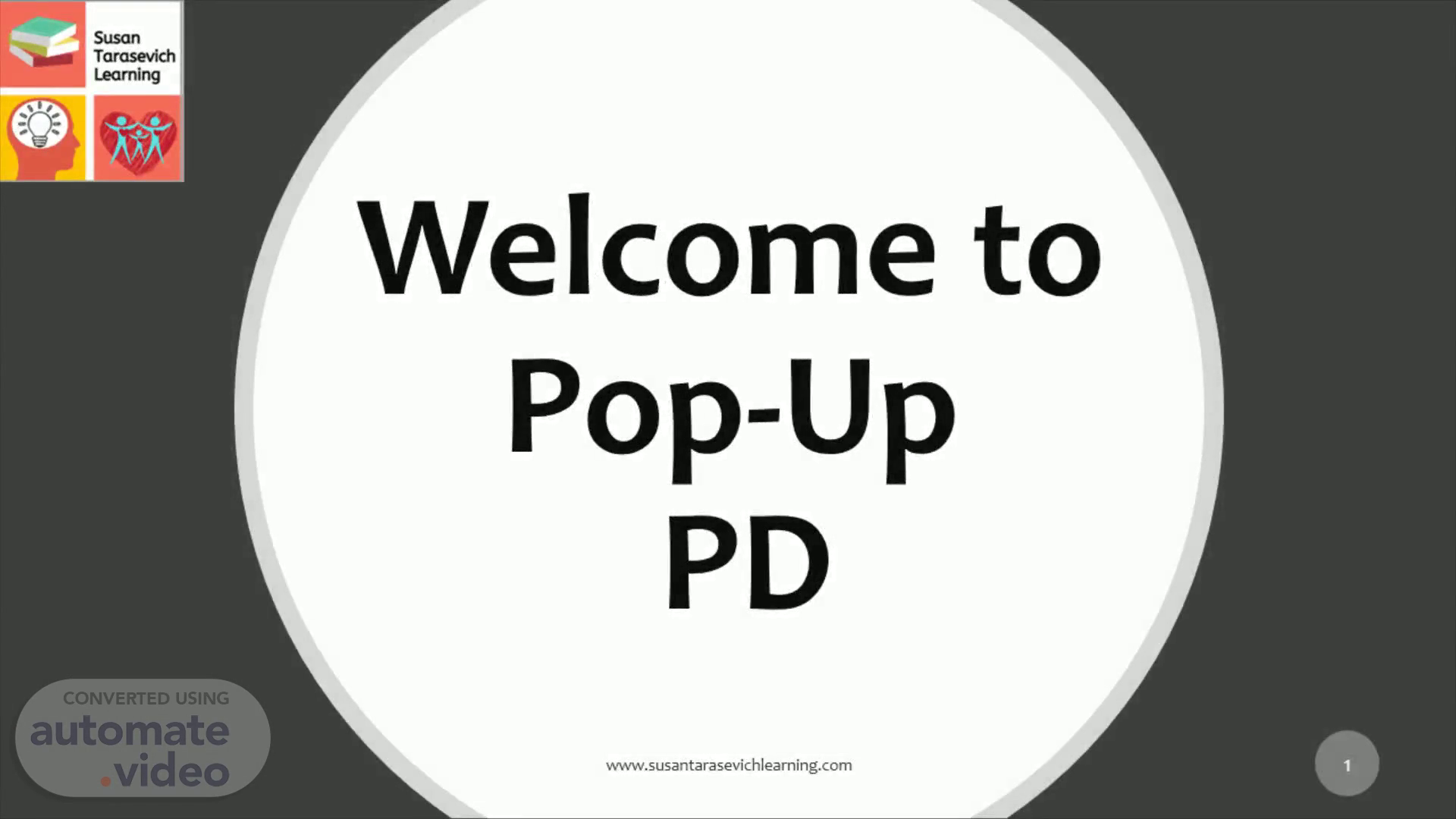
Page 1 (0s)
Welcome to Pop-Up PD. www.susantarasevichlearning.com.
Page 2 (9s)
Module One:. The Language. Digital art of brain. From Reticent to Responsive.
Page 3 (24s)
Space to stand or stretch Beverage Twenty-minutes together Materials Workbook, pens, post-it notes, markers.
Page 4 (36s)
Content Take-Away Action Relevance. Computer Generated Lights.
Page 5 (47s)
Plan to implement one new concept or idea from the training.
Page 6 (1m 13s)
What's Your Plan to Implement New Learning from this workshop in Your Practice Tomorrow?.
Page 7 (1m 28s)
Self-Care Mind Map for Educators. Some content can be disturbing. Use this Mind Map to support yourself throughout the training.
Page 8 (1m 52s)
Self-Care Mind Map for Educators. Some content can be disturbing. Use this Mind Map to support yourself throughout the training.
Page 9 (2m 23s)
2. Defining Trauma. Define trauma; review the causes of trauma; outline the five types of traumatic events.
Page 10 (2m 41s)
Computer Generated Lights. Every Session. www.susantarasevichlearning.com.
Page 11 (2m 52s)
Part One: Relevance. www.susantarasevichlearning.com.
Page 12 (3m 2s)
A silhouette of a person Description automatically generated with low confidence.
Page 13 (3m 34s)
abstract. Teens are NOT OK. Emotional Abuse – nearly 50% Persistent sadness/ hopelessness - 44% Seriously considered attempting suicide - 20% Poor mental health most of the time or always – 37% Attempted suicide in past 12 months – 9%.
Page 14 (4m 20s)
Teens are NOT OK. D ifficulty completing schoolwork – 66% Reported a parent or other adult in their home lost a job - 29% Experienced hunger - 24% Experienced physical abuse by an adult at home - 11%.
Page 15 (4m 43s)
About 33% reported use of tobacco products, alcohol or marijuana or misuse of prescription opioids Alcohol was the most common (20%), followed by vaping products (15%) and marijuana (13%). Over one-third of substance users said their use increased during the pandemic..
Page 16 (5m 5s)
Understand we are all healing from a global pandemic.
Page 17 (5m 32s)
Who are the kids we don’t kn o w y e t?. A person sitting in a classroom Description automatically generated with low confidence.
Page 18 (5m 55s)
common. high. Exposure to trauma in childhood is c __________ . Risk for exposure to more than one type is h____ ..
Page 19 (6m 6s)
Key Take-Aways so far…. Relevance ________________________ _____________________________________ _____________________________________ _____________________________________ _____________________________________.
Page 20 (6m 16s)
Safety is not the absence of threat, it is the presence of connection 1/hÖ.
Page 21 (6m 27s)
Computer Generated Lights. Every Session. www.susantarasevichlearning.com.
Page 22 (6m 38s)
Part Two: Content. www.susantarasevichlearning.com.
Page 23 (6m 47s)
What is trauma?. Define trauma and trauma-informed practices; review the causes of trauma.
Page 24 (7m 1s)
EVENT. OR series of events or circumstances. EFFECTS.
Page 25 (7m 18s)
ACUTE. A one time event – has a beginning and an end.
Page 26 (7m 43s)
Historical, Generational, Racial Trauma. Massive traumas like the holocaust, slavery, treatment of Native Americans impact worldview. Massive traumas affect the next generation often through heightened poverty, greater family work burden and more directly through survival messages “Don’t ask for help, its dangerous.”.
Page 27 (8m 2s)
Historical, Generational, Racial Trauma. What is racial trauma? The mental and emotional injury caused by encounters with racial bias, ethnic discrimination, microaggressions and hate crimes. Individual racism Systemic racism Who can be affected? Any individual that has experienced an emotionally painful, sudden, and uncontrollable racist encounter is at risk of suffering from a race-based traumatic stress injury [2]. In the U.S., Black, Indigenous People of Color (BIPOC) are most vulnerable due to living under a system of white supremacy..
Page 28 (8m 29s)
VICARIOUS TRAUMA. Our view of the world can become distorted based on listening to the stories of another’s traumatic experiences.
Page 29 (8m 43s)
COLLECTIVE TRAUMA. 29. Collective trauma impacts entire groups of people, communities or society. War in Ukraine COVID-19 Pandemic September 11, 2001, Terrorist Attack.
Page 30 (8m 58s)
One minute exercise: Pinky Thumb. Closeup of a face.
Page 31 (9m 11s)
A TRAUMA-INFORMED APPROACH. Asks: "What happened to you?" instead of "What's wrong with you?" It is designed to avoid re-traumatizing already traumatized people, with a focus on "safety first" (including emotional safety), and a commitment to do no harm..
Page 32 (9m 28s)
MEDICAL. Children experience painful treatments and procedures. Family members physical or mental illness leads to inconsistent food, communication, nurturing resulting in learning barriers.
Page 33 (10m 39s)
Teachable Moment. Ecology Drives Biology & They Drive Health Across the Lifespan The Good News is: Brains Can Change AND We are BRAIN CHANGERS.
Page 34 (10m 50s)
Computer Generated Lights. Every Session. www.susantarasevichlearning.com.
Page 35 (11m 1s)
Part Three: Take-Away’s. www.susantarasevichlearning.com.
Page 36 (11m 11s)
Dr Bruce Perry’s Neurosequential Model. Dr Bruce Perry’s Neurosequential Model.
Page 37 (11m 31s)
Things I Can Do Tomorrow:. 1. BUILD AWARENESS. COVID-19 has changed our collective culture. Students do well if they can Students need greater emphasis on teaching appropriate and positive behavior Shaming discipline practices only reinforce the trauma response.
Page 38 (11m 47s)
Things I Can Do Tomorrow:. List some ways that you can help all students in your class REGULATE when they arrive in your classroom: 1. 2. 3..
Page 39 (12m 6s)
Responsive Handbook. Responsive Activity. 39. Do I believe students are doing the best they can? Where do students’ negative behaviors come from? How does this knowledge shape the ways I communicate and relate with students?.
Page 40 (12m 20s)
Test - H eres the link:. www.susantarasevichlearning.com.